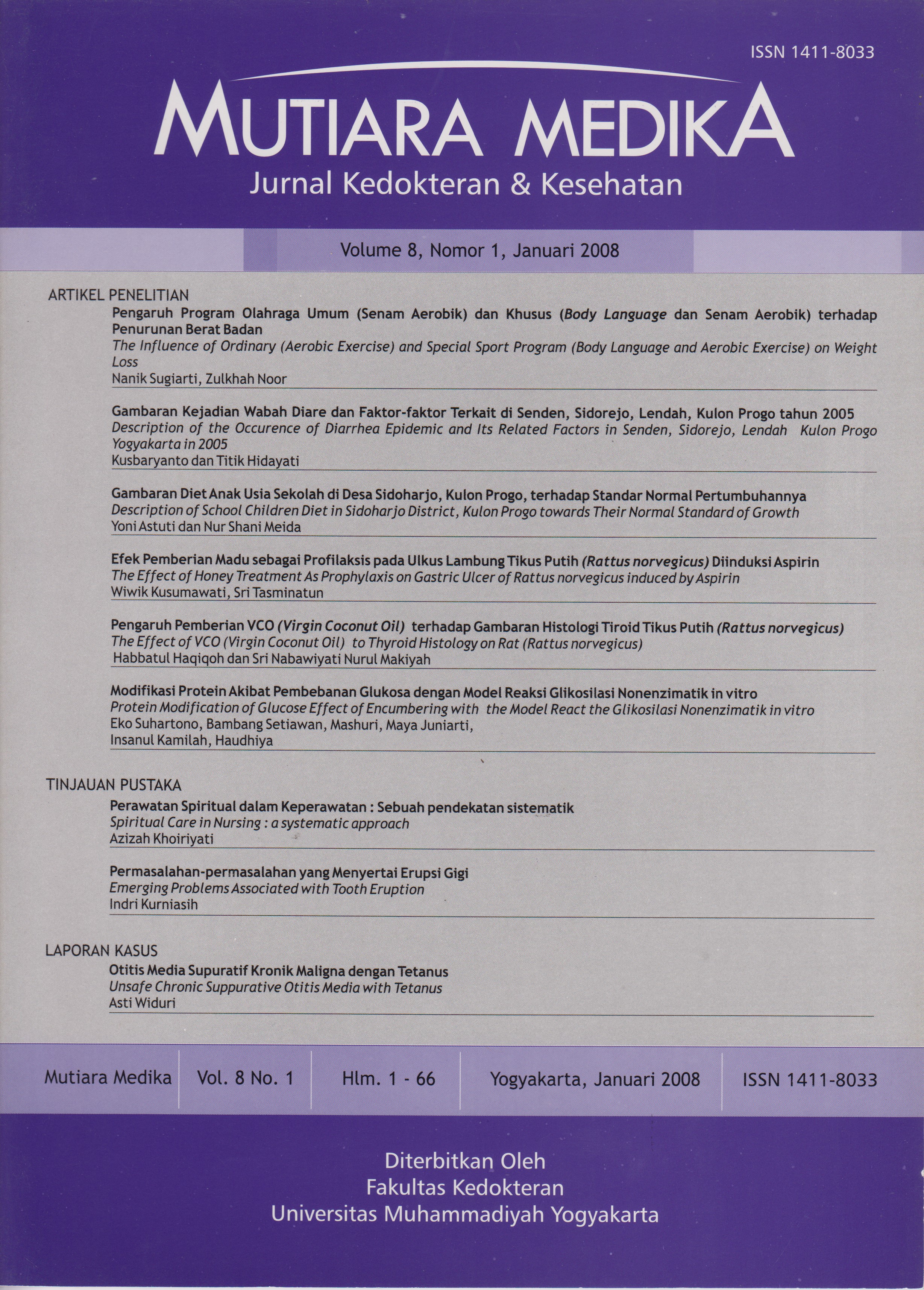Modifikasi Protein Akibat Pembebanan Glukosa dengan Model Reaksi Glikosilasi Nonenzimatik in vitro
DOI:
https://doi.org/10.18196/mmjkk.v8i1.1653Keywords:
AGEs, dikarbonil, glukosa, reaksi glikosilasi, tirosin, dicarbonyl compound, glucose, Glycocylation reaction, tyrosineAbstract
Glycocylation reaction causes protein modification. Glycocylation is a reaction between aldehyde group from reducing sugar with amine group of protein. The aim of this study was to measure Advanced Glycation End Products (AGEs) formation, dicarbonyl compound and tyrosine degradation in glycocylation reaction in vitro. A quasi experimental study was done to four treated groups, i.e. P1= 5 ml Bovine Serum Albumin (BSA), 10 ml phosphate buffer dan 10 ml aquadest; P2= 5 ml BSA, 10 ml phosphate buffer and 10 ml glucose 125 mM; P3= 5 ml BSA, 10 ml phosphate buffer and 10 ml glucose 250 mM; P4= 5 ml BSA, 10 ml phosphate buffer and 10 ml glucose 500 mM. AGEs compound was measured for 21 days using spectrophotometer at X = 390 nm. Dicarbonyl compound was measured by DNPH odification methods at X = 470 nm. Tyrosine degradation was measured usingMillon-Nasse reaction. Anova and Tuckey HSD test concluded there are significant difference between each groups (P<0,05). Based on correlation regresion test conclude that the increase of dicarbonyl compounds, AGEs and tyrosine degradation had positive correlation with increase of glucose concentration. Glucose overloading could induce protein modification in vitro.
Salah satu penyebab modifikasi protein adalah reaksi glikosilasi. Reaksi glikosilasi adalah reaksi antara gugus aldehid gula pereduksi dengan gugus amina protein. Penelitian ini bertujuan mengukur Advanced Glycation End Products (AGEs), senyawa dikarbonil maupun degradasi tirosin pada reaksi glikosilasi in vitro. Penelitian ini merupakan penelitian eksperimental semu denganpre andpost control group design terhadap empat kelompok perlakuan, yaitu P1= 5 ml Bovine Serum Albumin (BSA), 10 ml buffer fosfat dan 10 ml aquadest; P2= 5 ml BSA, 10 ml buffer fosfat dan 10 ml glukosa 125 mM; P3= 5 ml BSA, 10 ml buffer fosfat dan 10 ml glukosa 250 mM; P4= 5 ml BSA, 10 ml buffer fosfat dan 10 ml glukosa 500 mM. Absorbansi senyawa AGEs diukur selama 21 hari pada X = 340 nm sedangkan absorbansi senyawa dikarbonil diukur dengan X = 390 nm dan absorbansi degradasi tirosin dengan k=470 nm. Pengukuran absorbansi senyawa dikarbonil menggunakan metoda DNPH yang dimodifikasi, sedangkan pengukuran degradasi tirosin menggunakan reaksi Millon-Nasse. Berdasarkan hasil uji Anova dan Beda Nyata Jujur, disimpulkan bahwa terdapat perbedaan yang signifikan (P<0,05) tiap kelompok perlakuan. Berdasarkan uji korelasi regresi dapat disimpulkan bahwa pembentukan senyawa dikarbonil, AGEs dan degradasi tirosin berkorelasi positif dengan peningkatan konsentrasi glukosa. Pembebanan glukosa yang berlebih dapat memicu modifikasi protein in vitro.
References
Suhartono E., Setiawan B., Edyson, Mashuri. Modifikasi protein akibat reaksi Maillard dan pengaruhnya terhadap kadar tirosin. Jurnal Profesi Medika.2004;4(2):20-28.
Suhartono E., Rohman T., Setiawan B., Primasari AA. Model pembentukan Advance Glycation End Products dan modifikasi protein akibat reaksi glikosilasi. Maj.Kedokt.Indon. 2005;55(11):681-685.
Suhartono E., Setiawan B., Mashuri. Model pembentukan Advance Glycation End Products dan modifikasi degradasi tirosin akibat reaksi maillard. Jurnal Kedokteran Yarsi. 2005;13(1):50-55.
Damayanthi ED., Qamariah N., Suhartono, E., Penghambatan kerusakan protein oleh infus batang tanaman brotowali (Tinospora crispa L. Miers) akibat konsentasi glukosa berlebih in vitro. Berkala Kedokteran. 2003; 3(1):27-32.
Budianto R., Qamariah N., Suhartono, E., Potensi infus daun pare (Momordica charantia) sebagai penghambat kerusakan protein akibat reaksi glikosilasi. Majalah Obat Tradisional. 2003; 8(25):1-5.
Firdaus TF., Suhartono E., Qamariah N. Pemodelan reaksi glikosilasi dan peran infus daun tapak dara (Chataranthus roseus [L] F. Don) sebagai penghambat kerusakan protein. Berkala Ilmu Kedokteran. 2004; 36(1):1-6.
Suhartono E., Setiawan B., Edyson, Yuliasari N. Uji aktivitas antioksidan rebusan daun dewa (Gynura Pseudichina) sebagai inhibitor Advance Glycation End Products (AGEs) dan Senyawa dikarbonil akibat reaksi glikosilasi. Mutiara Medika.2004; 4(2):104-113.
Suhartono E., Rohman T., Setiawan B., Dedya O. Laju inhibisi Advance Glycation End Products oleh perasan belimbing wuluh (Averrhoa bilimbi Linn) berdasarkan aktivitas antioksidan in vitro. Majalah Obat Tradisional. 2005; 10(31):7-11.
Suhartono E., Setiawan B., Edyson, Ramlah. Uji aktivitas antioksidan jus buah mengkudu (Morinda citrifolia) dan perannya sebagai inhibitor Advance Glycation End Products (Senyawa dikarbonil) akibat reaksi glikosilasi. Berkala Ilmu Kedokteran. 2005; 37(1):1-6.
Forbes JM, Cooper ME, Thallas V, Burns WC, Thomas MC, Reduction of the accumulation of advanced glycation end products by ACE inhibition in experimental diabetic nephropathy. Diabetes. 2002; 51:3274-82.
Matsuoka T, Kajimoto Y, Watada H. Glycation-dependent, reactive oxygen species-mediated suppression of the insulin gene promoter activity in HIT cells. J.Clin. Invest 1997; 99:144-50.
Oldfield MD, Bach LA, Forbes JM. Advanced glycation end products cause epithelial-myofibrobalst transdifferentiation via the Receptor for Advanced Glycation End products (RAGE). J. Clin. Invest. 2001; 108:1853-63.
Ueno Y, Kizaki M, Nakagiri R, Kamiya T, Sumi H, Osawa T. Dietary gluthatione protects rats from diabetic nephropathy and neuropathy. J. Nutr. 2002; 132:897-900.
Droge W. Free radicals in the physiological control of cell function. Physiol Rev 2002; 82:47-95.
Beckett AH, Kalsi VS. Compelling need for suplementation:”How specific nutrients help retard the complications of diabetes melitus. Makalah pada Symposium "Compeling Need For Nutrient Therapy in The Treatment of Diabetes Mellitus and The Associated Complications; 2003 Februari 8, Surabaya, Indonesia: Pusat Diabetes dan Nutrisi Surabaya; 2003.
Shoda H, Miyata S, Liu BF. Inhibitory effect of tenilsetam on the Maillard reaction. Endocrinology 1997; 138:1886-92.
Valencia JV, Weldon SC, Quinn D. Advanced Glycation End Product ligand for the receptor for Advanced Glycation End Product: biochemical characterization and formation kinetics. Analytical Biochemistry 2004; 324:68¬78.
Uchida K, Kanematsu M, Sakai K, Matsuda T, Hattori N, Mizuno Y, et al. Protein-Bound acrolein: Potential markers for oxidative stress. Proc. Natl. Acad. Sci. USA 1998; 95:4882-7.
Sadikin M. Pengukuran Konsentrasi Senyawa Karbonil. Makalah dalam Kursus Penyegar dan Pelatihan: Radikal Bebas dan Antioksidan: Dasar, Aplikasi dan Pemanfaatan Bahan Alam. Jakarta, 21-22, April 2001.
Fessenden RJ, Fessenden JS. Karbohidrat. Dalam: Kimia organik, edisi ke 3 Alih bahasa: A. Hadyana Pudjaatmaka, Penerbit Erlangga. Jakarta. 1986.
Lee C, Yim MB, Chock PB, Yim HS, Kang SO. Oxidation-reduction properties of methyglyoxal-modified protein in relation to free radical generation. J. Biol. Chem, 1998; 273:39.
Baynes JW, Thorpe SR. Role of oxidative stress in diabetic complications. Diabetes 1999; 48:1-9.
Babloyantz A. Molecules, dynamics & live: an introduction to self-organization of matter. Singapore; John Wiley & Sons; 1986.
Downloads
Published
Issue
Section
License
Copyright
Authors retain copyright and grant Mutiara Medika: Jurnal Kedokteran dan Kesehatan (MMJKK) the right of first publication with the work simultaneously licensed under an Attribution 4.0 International (CC BY 4.0) that allows others to remix, adapt and build upon the work with an acknowledgment of the work's authorship and of the initial publication in Mutiara Medika: Jurnal Kedokteran dan Kesehatan (MMJKK).
Authors are permitted to copy and redistribute the journal's published version of the work (e.g., post it to an institutional repository or publish it in a book), with an acknowledgment of its initial publication in Mutiara Medika: Jurnal Kedokteran dan Kesehatan (MMJKK).
License
Articles published in the Mutiara Medika: Jurnal Kedokteran dan Kesehatan (MMJKK) are licensed under an Attribution 4.0 International (CC BY 4.0) license. You are free to:
- Share — copy and redistribute the material in any medium or format.
- Adapt — remix, transform, and build upon the material for any purpose, even commercially.
This license is acceptable for Free Cultural Works. The licensor cannot revoke these freedoms as long as you follow the license terms. Under the following terms:
Attribution — You must give appropriate credit, provide a link to the license, and indicate if changes were made. You may do so in any reasonable manner, but not in any way that suggests the licensor endorses you or your use.
- No additional restrictions — You may not apply legal terms or technological measures that legally restrict others from doing anything the license permits.






